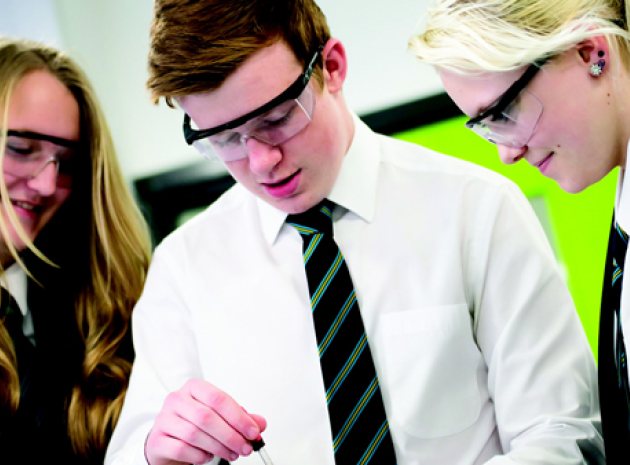Try Dr Joanna Rhodes’ inspiring activities designed to increase students’ understanding of one of our planet’s most fascinating resources…
TODAY YOU WILL...
LEARN ABOUT: CRUDE OIL AND ITS USES; THE EXTRACTION AND USES OF VEGETABLE OILS; PLANT OILS; FRAGRANCES; AND COOKING. + DESIGN AND MAKE YOUR OWN PERFUME
This lesson and supporting activities are dedicated to a type of substance that drives the world economy as well as being able to help you get to sleep when you have a cold. It is, of course, oil. In its many varied forms from crude oil to fuels and vegetable oil to essential oils and perfume, this variously viscous substance provides a fascinating and multifarious topic with huge potential to thrill and excite students and with many opportunities for practical work. Cross-curricular links exist with geography, politics and economics and health and beauty. There are also opportunities for social, moral, spiritual and cultural content to be explored, including awareness of the unique position of oil in world conflict, pollution, recycling and deforestation.
STARTER ACTIVITY
FRACTIONAL DISTILLATION OF CRUDE OIL
Students are almost always fascinated to see a sample of crude oil for the first time and a healthy question and answer session about it as a useful substance providing fuels, polymers and plastics is a thought provoking way to introduce the lesson. Learners will have their own ideas of what they think crude oil looks like and are often surprised at how watery and thin it is compared to their visions of thick tar. Synthetic crude oil for fractional distillation can be purchased for school use and CLEAPPS should be consulted for safe procedure for the demonstration [AR1]. The apparatus can produce petrol, naphtha and diesel fractions, which can be collected and examined then burned in the laboratory. Students will enjoy burning their fuels and may be surprised by their appearance and viscosity. Their understanding of the process can be broadened at this stage leading to the essential knowledge of how properties of hydrocarbons are dependent on the number of carbons in the chains and the way this affects boiling point and viscosity.
MAIN ACTIVITIES
1 ESSENTIAL OILS
This is a super activity for the summer months as flowering plants are readily available. It also smells wonderful and really captures the imagination of students. Steam distillation is a simple technique that can be carried out with basic distillation equipment, water and a range of plant specimens [AR2]. Ask students to carry out a Web Quest to investigate perfumes and essential oils and design their own perfume. They could create a delicate perfume with roses and freesias; a cold remedy with pine and eucalyptus; or even an oriental themed scent with jasmine and orchids. Once students have ‘designed’ their fragrance they simply need to introduce the components into the roundbottomed flask of the distillation equipment along with 50 ml of clean water and some anti-bumping granules. Heat gently until the water boils and collect the distillate. The resulting ‘perfume’ will have droplets of plant oils floating on the water and smell very pleasant. It is even safe enough for students to bottle and take home providing care is taken not to use unidentified or potentially poisonous plants such as foxgloves or nightshade. To add an element of creativity students can design labels for their bottles and marketing or merchandising material.
2 OIL CONFLICT
In this fully resourced activity from Frontlineworld [AR3] students propose some strategies for reducing the negative impact of oil development on the people of Colombia and the environment.
First, get up to speed on the key issues and players involved in Colombia's pipeline war using the video resources and extensive profiles available online [AR3] – then brainstorm in groups. Finally, have a town meeting to discuss some key questions: 1) What strategies are the most viable for preventing pipeline oil spills and protecting civilians? 2) On what issues does it make the most sense for the parties to compromise? 3) Among these parties, who carries the largest sense of responsibility for making change? Debrief with students about the town meeting, and if possible, encourage students to share their ideas by producing an information leaflet or factsheet. This activity has strong elements of SMSC and cross-curricular links with geography and politics.
HOME LEARNING
1. Biofuels and changing fortunes
Biofuels are a desirable and carbon neutral alternative to crude oil. They are made from plants, meaning that the growing vegetation removes carbon dioxide, which is subsequently released by burning the fuel. As long as the cycle continues it remains carbon neutral. However the fuel crops often cause deforestation and food hardship as this article from the Economist highlights very clearly [AR9]. Ask students to investigate the pros and cons of biofuels and present their work as a balanced argument. Alternatively set up a debate for the following lesson with a motion “This house believes that biofuels are the best sustainable fuel for the future”. Divide the class into teams of students who will either propose or oppose the motion.
2. Supermarket sweep
Ask students to carry out a supermarket sweep of the different types of food oils that are available and their percentages of saturated and unsaturated fats. Compare these values with the traffic lights on the bottles. Which fats and oils are healthier for us and which can cause health problems? Back in the lesson students can use samples of selected oils to test for the level of unsaturation as described in this experiment from the Nuffield Foundation
SUMMARY
MOJA ISLAND
Burning fossil fuels such as crude oil has been blamed for global warming and rising sea levels. A fuel train is a good way of demonstrating the carbon dioxide released by combustion [AR4]. In this demonstration a solid hydrocarbon burns and a pump is used to draw the gaseous combustion products through limewater to show the presence of carbon dioxide. After showing students the fuel train, play the energy loop game from Practical Action [AR5] to get learners thinking about energy sources and alternative sources of energy. Students then reinforce their understanding of renewable energy sources by modelling with Moja Island [AR6]. In this activity they consider the variety of different energy options available to communities living on Moja Island and select the most appropriate technology. Renewable energy fact cards, a map of the island, and information on the different communities and their needs are all resources vibrantly and beautifully designed by Practical Action to help them.
KEY RESOURCE
THE ROYAL SOCIETY OF CHEMISTRY’S EDUCATION WEBSITE, LEARN CHEMISTRY, IS A FREE ONLINE PLATFORM FULL OF THOUSANDS OF CHEMISTRY RESOURCES – INCLUDING EXPERIMENTS, WORKSHEETS, VIDEOS, SIMULATIONS, AND GAMES – FOR TEACHERS AND STUDENTS TO EXPLORE. THE CONTEXT-BASED MATERIALS ARE DESIGNED TO ENCOURAGE STUDENTS TO APPROACH CHALLENGES THROUGH PROBLEM SOLVING AND ANALYTICAL THINKING, AND HAVE BEEN CREATED FOR USE WITH PUPILS AT VARYING LEVELS OF ABILITY. TEACHING MATERIALS RELATE TO EVERYDAY LIFE AND REAL-WORLD CHALLENGES AND NEW MULTIMEDIA RESOURCES ARE ADDED EVERY MONTH. LEARN CHEMISTRY IS A 2013 BETT AWARD FINALIST AND WON AN EDUCATION RESOURCES AWARD IN THE CATEGORY ‘SECONDARY RESOURCE OR EQUIPMENT’. VISIT RSC.LI/LEARN-CHEMISTRY
INFO BAR
STRETCH THEM FURTHER
+ THE OIL ECONOMY AS A MAJOR DRIVER OF THE WORLD’S ECONOMY OIL COMPANIES USE THEIR REFINERIES TO MEET SUPPLY AND DEMAND OF THE MAIN FRACTIONS OF CRUDE OIL SUCH AS PETROL AND DIESEL [AR7]. IN THIS ACTIVITY STUDENTS IMAGINE THEY ARE ON THE BOARD OF DIRECTORS OF AN OIL COMPANY AND NEED TO BALANCE THE SUPPLY OF CRUDE OIL WITH THE DEMAND FOR BOTH PETROL AND DIESEL. AT THEIR DISPOSAL ARE CATALYTIC CRACKING (WHICH CAN TURN DIESEL INTO PETROL) [AR8] AND CHANGING THE PRICE THEY CHARGE FOR PETROL AND DIESEL. A REALISTIC APPROACH IS TO GIVE EACH TEAM A GRAPH PROJECTING THE SUPPLY AND DEMAND OF PETROL AND DIESEL ON A GRAPH FOR THE NEXT MONTH AND ASK THEM TO SCHEDULE THEIR REFINERY FOR WHEN THEY WILL DO THE MOST CATALYTIC CRACKING TO MAKE PETROL AND THE PRICE VARIATIONS THEY EXPECT TO EMPLOY. STUDENTS CAN PRODUCE A PRESENTATION TO THE BOARD OF DIRECTORS, FURTHER DEMONSTRATING SKILLS IN ORAL PRESENTATION.
ADDITIONAL RESOURCES
AR1] ROYAL SOCIETY OF CHEMISTRY: FRACTIONAL DISTILLATION OF CRUDE OIL TINYURL.COM/TSEO1
[AR 2] ROYAL SOCIETY OF CHEMISTRY: STEAM DISTILLATION OF LIMONENE TINYURL.COM/TSEO2
[AR 3] FRONTLINEWORLD: CONFLICT IN COLOMBIA TINYURL.COM/TSEO3
[AR 4] ROYAL SOCIETY OF CHEMISTRY FUEL TRAIN: TINYURL.COM/TSEO4
[AR 5] PRACTICAL ACTION: LOOP GAME TINYURL.COM/TSEO05
[AR 6] PRACTICAL ACTION: MOJA ISLAND TINYURL.COM/TSEO6
[AR 7] TELEGRAPH: DIESEL SHORTAGE TINYURL.COM/TSEO7
[AR 8] ROYAL SOCIETY OF CHEMISTRY: CATALYTIC CRACKING TINYURL.COM/TSEO8
[AR 9] THE ECONOMIST: ETHANOL TANKS TINYURL.COM/TSEO09
[AR 10] THE NUFFIELD FOUNDATION: FATS AND OILS TINYURL.COM/TSEO10
ABOUT THE EXPERT
Dr Joanna L. Rhodes M.Chem, D.Phil, MRSC is a teacher of science at Shelley College, Huddersfield.










